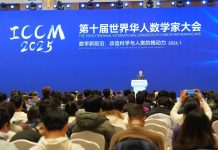
Cai Jun, a 45-year-old suspense novelist, had memorized the telegraph codes for the most commonly used Chinese characters when he was studying at a vocational college nearly 30 years ago. Under the Chinese telegraph system, a four-digit code was assigned to each character. However, telegraphs were no longer in civil use by the time he graduated, so his vocational education went to waste.
Telegraphs were an important means of long-distance communication decades ago. Through telegraphs, it might have taken as long as five or six hours for a message to reach its recipient, which is unimaginable today.
Dou Shuohua, a 65-year-old retiree from Shandong Province, told Beijing Review that when he was a kid, his parents would go to the post office to send telegraphs to his aunt living in another city of the province and telegrapher was once considered a decent job. In a telegraph building, a mechanical conveyor working 24 hours a day was like the production line of a factory. The telegraph order sheets were attached to the conveyor with slips of different colors, which indicated different degrees of urgency.
Sometimes telegraphers needed to work through the night, such as after the massive 1976 Tangshan earthquake that killed 240,000 people in Hebei Province, when people from across the country sent telegraphs to Tangshan, asking if their friends and relatives were safe.
With the popularization of modern methods of communication such as phones and fax machines, telegraphs are rarely used today, except for special purposes such as in the military.
Telegrapher is just one of the occupations that had been removed from the 2015 version of the Occupational Classification Code of the People’s Republic of China. More than 200 occupations had been deleted from that version compared with those from the previous version published in 1999, which was also the first version of the code. The occupations taken out of the 2015 version also included embroiderer, bus conductor and itinerant mender of pots.

Old professions
Technological progress is one of the primary reasons occupations disappear.
For instance, pagers were a common method of communication in the 1990s. Pagers could not send but only receive messages.
A receptionist was needed to send messages to the pager users. When A wants to contact B, who has a pager, he or she will call the receptionist who will message B A’s phone number and B will find the closest public phone to call A.
These receptionists were mostly women and the profession was once desirable as their salaries were as high as 800 yuan ($96 at the time) a month. According to the National Bureau of Statistics, the average monthly salary of urban employees in China was 458 yuan ($55 at the time) in 1995.
As landline phones and mobile phones became commonplace, pagers gradually disappeared, and so did the pager receptionist profession.
Switchman is another profession that was deleted in the 2015 version of the Occupational Classification Code. In the days when trains switched tracks manually, a switchman was needed to carry out the process.
An Guitao, who is 60 now, was a switchman for more than 30 years at Mentougou Railway Station in Beijing. His work was to operate the switch manually to ensure the train could pull in safely at the station. The work involved heavy manual labor.
As there were eight coal mines near the station, there were a large number of trains stopping at the station to transport coal every day. An sometimes had to operate the switch more than 200 times a day and hardly had time for lunch.
However, as today’s railway system has become much more automated, the role of switchman is no longer necessary. Instead, railroad staff members now control the railway switch electronically.
It’s worth noting that although some traditional occupations have not disappeared, they have developed more subcategories. For instance, the improvement of people’s living standards has led to higher demand for food. People are no longer satisfied with just filling their stomachs. They need a wider variety of food and a healthier diet. Therefore, new professions under the cook category have emerged, including Chinese food cook, Western food cook and public nutritionist, who provides nutritional guidance and spreads nutritional and food safety knowledge to promote public health.

Emerging needs
As old professions have disappeared, a number of new professions have emerged. For instance, the rapid growth of e-commerce in recent years has boosted the development of the express delivery sector. China’s annual express delivery volume surpassed 120 billion as of December 4 this year, setting a new record.
The achievement could not have been made without the hard work of couriers. The 2015 version of the Occupational Classification Code included courier delivering parcels for the express delivery sector as a new occupation.
As China has set the dual carbon goals of peaking carbon emissions before 2030 and achieving carbon neutrality before 2060, the requirement for building energy efficiency has also increased. A new profession called building energy conservation and emission reduction consultant was included in the 2022 version of the Occupational Classification Code.
Zhang Weiqiu, a building energy conservation and emission reduction consultant with JD Property, the infrastructure management subsidiary of Chinese e-commerce giant JD, told Global Times newspaper that one needs to have an expertise in fields such as building insulation, solar photovoltaic power generation and rainwater recycling to be a qualified consultant.
During a building’s design stage, the consultant takes into consideration factors such as building orientation, materials, heating and cooling systems to improve the building’s energy efficiency. In the construction phase, the consultant cooperates closely with the construction team to ensure the correct installation of energy saving equipment and after the building is put into operation, the consultant needs to monitor the energy consumption of the building and provide solutions to further reduce energy consumption.

The development of new industries such as esports and livestreaming has also given rise to new professions.
For instance, short video platforms have given birth to new professions such as livestream hosts and short play directors.
According to a report published by the Chinese Academy of Personnel Science in November, short video platforms have incubated many new occupations. More than 80 percent of traditional occupations have combined with short video platforms to create new professions such as real estate agents who sell houses through livestreaming.
A report released by the China Audio-Video and Digital Publishing Association’s electronic sports committee in February this year said that China’s esports industry achieved a revenue of 144.5 billion yuan ($20.1 billion) and Chinese esports audiences and players totaled 488 million in 2022, both ranking first in the world.
The thriving industry has boosted demand for esports players. There will be a demand for 2 million esports players between 2020 and 2025, according to a report published in 2020 by China Employment Training Technical Instruction Center and DingTalk, e-commerce giant Alibaba’s workplace messaging app. And esports player was also included in the 2022 version of the Occupational Classification Code.
Over the past 45 years of reform and opening up, the occupation system has undergone great changes, with the number of occupations continuously expanding. For instance, compared with the 2015 version, the 2022 version of the Occupational Classification Code added 158 new professions, bringing the total number of occupations to 1,639. The adjustment of the occupations has also had an influence on individuals, who have needed to adapt. For instance, Cai Jun, mentioned at the beginning of the story, who had wanted to be a telegrapher, became a best-selling suspense novelist. –The Daily Mail-Beijing Review news exchange item





